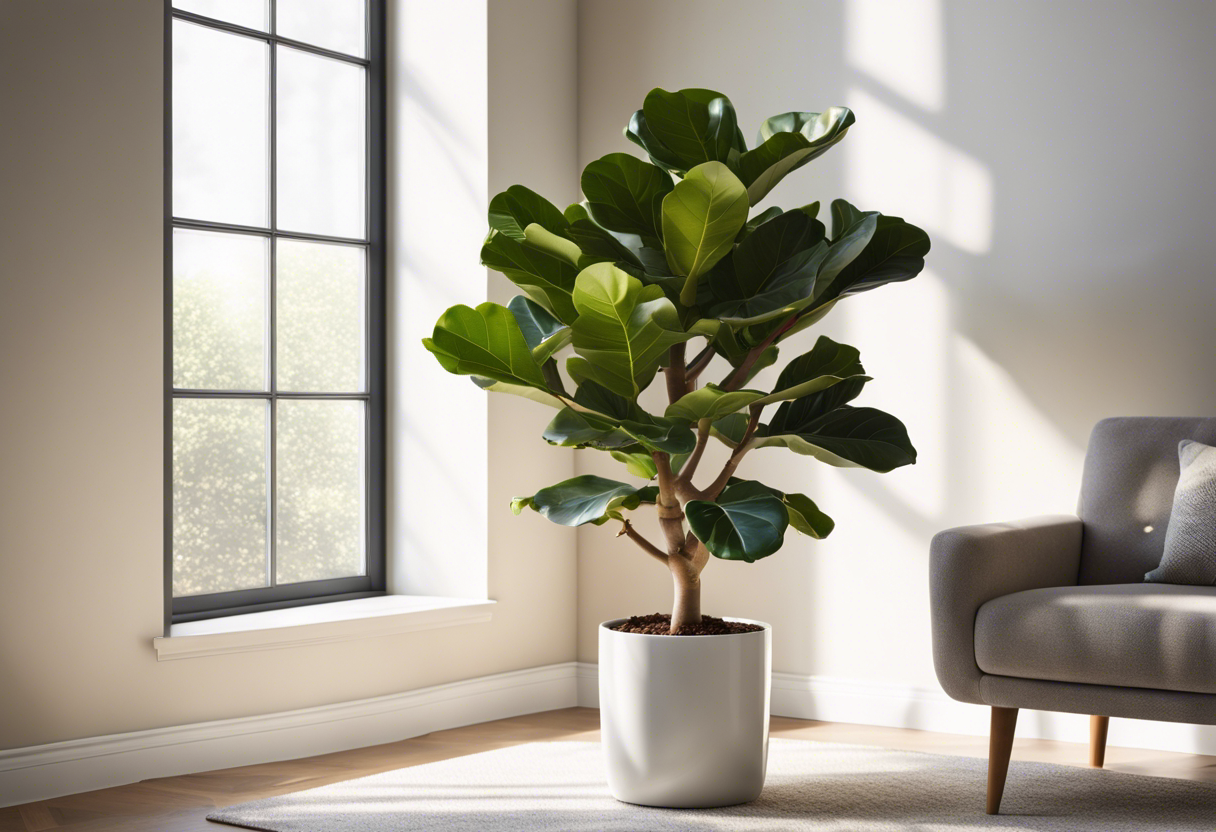Ever found yourself in a panic, staring at your once vibrant fiddle-leaf fig now looking more like a droopy, brown-leafed disaster? Well, you’re not alone. I’ve been there too, frantically Googling How to Revive a Dying Fiddle-Leaf Fig at 2 AM.
But don’t lose hope just yet! With the right knowledge and some TLC, your leafy friend can bounce back from the brink. So stick around and let’s nurse that fig back to health together. Keep reading about ‘How to Revive a Dying Fiddle-Leaf Fig’.
Key Takeaways
- Identify signs of a dying fiddle-leaf fig such as drooping or discolored leaves.
- Overwatering is a common cause; ensure the plant isn’t sitting in water and allow the soil to dry between watering.
- Provide indirect sunlight, ideally in an east-facing window.
- Maintain a humid environment, misting the leaves regularly.
- Use a well-draining soil mix and consider repotting if root rot is suspected.
- Prune dead leaves and branches to promote new growth.
Understanding Fiddle-Leaf Fig Problems
Alright, let’s get down to the nitty-gritty. Your fiddle-leaf fig is looking a bit under the weather and you’re wondering why. Well, there are several common Fiddle-Leaf Fig problems that could be causing your plant to feel a bit off.
Identifying Common Signs of a Dying Fiddle-Leaf Fig
First things first, we need to look for signs. Is your Fiddle-Leaf Fig dropping leaves like they’re hot? Or maybe it’s got some weird brown spots popping up all over its once lush green foliage? These are classic signs of a dying Fiddle-Leaf Fig.
If you notice that your plant has lost its vigor and seems more droopy than usual, then it’s time to put on your detective hat. You’ve got an unhealthy Fiddle-Leaf Fig on your hands and we need to figure out what’s wrong.
Understanding the Causes of These Symptoms
Now, let’s talk about why this might be happening. There could be several reasons for these symptoms in your fiddle leaf figs. Maybe it’s getting too much sun or not enough water? Or perhaps it’s just feeling a bit claustrophobic in that tiny pot of yours?
These are all potential triggers for ill health in Fiddles Leaf-Fig. So before you start panicking about how to revive a dying fiddle-leaf fig, take a moment to understand what might be causing these issues in the first place.
Assessing Your Fiddle-Leaf Fig’s Environment
When it comes to how to revive a dying fiddle-leaf fig, understanding its environment is crucial. The fiddle-leaf fig environment plays a significant role in the plant’s overall health. It’s all about the right balance of light, temperature, humidity, soil, and pot conditions.
Evaluating Light Conditions
First things first – let’s talk about light. Your fiddle-leaf fig is like that friend who loves their sunnies but can’t handle too much sun. It needs bright but indirect sunlight. So, if your plant looks a bit off-color or droopy, it might be crying out for more light.
On the other hand, too much direct sunlight can cause leaf burn. Ouch! So, remember to strike a balance with your fiddle-leaf fig light requirements.
Checking Temperature and Humidity Levels
Next up – temperature and humidity. These divas prefer temperatures between 65 and 75 degrees Fahrenheit (18 – 24°C) and love some good humidity levels around them. If you see yellowing leaves or leaf drop, it could be due to incorrect temperature or low humidity.
Remember folks, these plants are tropical natives! They like it warm and humid just like their natural habitat. Keep an eye on your thermostat and consider getting a humidifier if needed to meet your indoor plant temperature needs.
Examining Soil and Pot Conditions
Last but not least – soil and pot conditions. Your fiddle-leaf fig likes well-draining soil that’s rich in organic matter. If you notice root rot or slow growth, poor soil quality might be the culprit.
As for the pot size? Well, bigger isn’t always better here! A snug fit encourages healthy root growth so don’t go overboard with the pot size when considering your indoor plant potting needs.
Remember, assessing plant environment is key to understanding how to keep your fiddle-leaf fig happy and healthy.
Reviving Your Fiddle-Leaf Fig: Immediate Actions
When your fiddle-leaf fig starts singing the blues, it’s time for some immediate plant care actions. Reviving dying plants, especially a fiddle-leaf fig, requires a bit of TLC and knowledge about fiddle-leaf fig care.
Adjusting Watering Practices
First things first, let’s talk water. Overwatering or underwatering can turn your green thumb brown real quick. So, what are the optimal watering practices? Well, think of your fiddle-leaf fig as a Goldilocks – not too much water, not too little, but just right. This means you should only water when the top inch of soil is dry. Remember, indoor plant watering tips aren’t just suggestions; they’re lifelines for your leafy friends.
Pruning Damaged Leaves and Branches
Next up on our fiddle-leaf fig revival mission is pruning. Spotting and snipping off damaged leaves and branches can be a game-changer in promoting healthy plant growth. It’s like giving your plant a fresh haircut to look its best! But remember to be gentle; we’re revitalizing through pruning here, not auditioning for a topiary competition. With these indoor plant pruning techniques in hand, you’ll have your fiddle-leaf looking fab in no time!
Long-Term Care Strategies for a Healthy Fiddle-Leaf Fig
When it comes to how to revive a dying fiddle-leaf fig, long-term care strategies are just as important as immediate fixes. It’s all about creating an environment where your plant can thrive.
Choosing the Right Soil and Fertilizer
Choosing the right soil and fertilizer is like picking out the perfect home for your fiddle-leaf fig. The best soil for fiddle-leaf fig is well-draining and nutrient-rich, so your plant has room to grow without getting waterlogged. As for fertilizers, opt for organic fertilizers for plants that provide essential nutrients without harsh chemicals.
Regular Maintenance Tips
Keeping up with regular maintenance tasks is key to fiddle-leaf fig care. This includes watering when the top inch of soil feels dry, not when the calendar tells you to. Also, don’t forget about pruning! A little snip here and there can help your plant maintain its shape and promote new growth. Remember, caring for a fiddle-leaf fig isn’t a one-time thing—it’s a long-term commitment!
Preventive Measures to Keep Your Fiddle-Leaf Fig Healthy
Keeping your fiddle-leaf fig in top shape isn’t rocket science. It’s all about fiddle-leaf fig care, pest prevention, and creating optimal growth conditions. Think of it as a plant health maintenance routine.
Monitoring for Pests and Diseases
Now, let’s talk bugs and diseases. You don’t want these uninvited guests crashing your fiddle-leaf fig party. So, how do you keep an eye out? Start with regular plant health monitoring.
Check the leaves, stems, and soil for any suspicious activity. If you spot tiny critters or weird leaf spots, that’s a red flag! These are common disease symptoms in fiddle-leaf figs.
Don’t freak out though! Most indoor plant pests can be dealt with using eco-friendly pesticides or DIY solutions. Remember, early detection is key when dealing with pests and diseases.
Ensuring Optimal Growth Conditions
Next up on our ‘How to Revive a Dying Fiddle-Leaf Fig’ guide: creating the perfect environment for your plant baby. This involves understanding the fiddle-leaf fig light requirements and watering needs.
Your fiddle-leaf fig loves bright but indirect sunlight. Too much direct sun can cause leaf burn while too little light can stunt its growth. It’s all about balance!
Watering is another crucial aspect of optimal plant growth conditions. Overwatering can lead to root rot while underwatering can dry out the plant. The trick is to water thoroughly but infrequently.
Remember folks, every fiddle-leaf fig has its own personality (yes, they’re like people!). Pay attention to its needs and adjust your care routine accordingly for successful indoor plant care.
To Wrap Up
Just like reviving a wilted romance, learning How to Revive a Dying Fiddle-Leaf Fig requires patience, love, and the right moves. Remember, your fig is not just a plant; it’s the green embodiment of hope in your living room.
So folks! Don’t let your fiddle-leaf fig sing its swan song yet. With these tips, you can nurse it back to health and let it strum its vibrant notes again.





